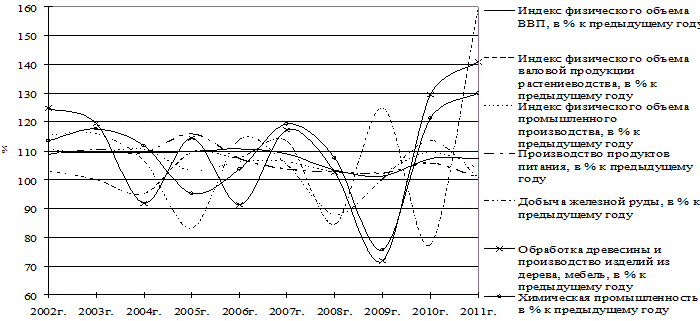Economic crisis. Classification and frequency of crises. Recession.
Business cycle:the economy-wide fluctuations in output, incomes, inflation, and employment. Although characterized by common phases - peak, recession, trough, recovery - business cycles vary greatly in duration and intensity.
Although the business cycle has been explained in terms of such ultimate causal factors as capital innovations, weakening of the multiplier effect, political events, and money creation, it is generally agreed that the level of total spending is the immediate determinant of national output and employment.
Recessionand recoveryare the main phases of the business cycle. In the recessionoutput and employment both decline, but prices tend to be relatively inflexible in a downward direction. The price level is likely to fall only if the recession is severe and prolonged - that is, if a "depression" occurs.
In the recoveryphase the economy's levels of output and employment expand toward full employment. As recovery intensifies, the price level may begin to rise prior to the realization of full employment and capacity production.


Amplitude of fluctuations - a degree of change of economic activity from the maximum up to the lowest point.
The period of a cycle - a time interval between two points which are being at identical stages of cyclic fluctuations.
The trend is a result of action of the factors causing long-term growth in economy while business-cycle represents a time deviation from the given tendency.
Allocate following phases of a business cycle: Rise (revival, growth,); 2. Peak; 3. Recession (recession, crisis); 4. Depression, stagnation.
Expansion of business activity begins the conclusion of new contracts, increase of a consumer demand therefore the volume of manufacture increases, growth of manufacture leads to the further growth of incomes, etc. of economy still more more amplifies due to growth of volume of given out credits. Increase of employment of resources and cumulative demand leads to a rise in prices. Gradually there is a saturation of a consumer demand and at the same time the increased price of a domestic production forces buyers to pass to import products. The phase of rise shares on two parts: 1 - revival in which end the economy reaches the potential and 2 - growth in which end the economy reaches peak of the development (the greatest possible volume of manufacture and consumption). At the same time the economy of any country is subject to influence of set of external and internal factors, therefore often there is a situation when the economy, at all not having reached the greatest possible manufacture, passes in a phase of recession.
When the economy is in a phase peak economic growth stops, there are first attributes of instability: the volume of trading operations decreases and less often transactions consist. In economy recession begins. The proceeds of sellers are reduced, and businessmen, having collided with shortage of money for payment of the salary, as a rule, prefer it to not reduce, and to dismiss "superfluous" workers since the size of payment is fixed in contracts. Therefore in the beginning of this stage of the price for production do not decrease (firms bought resources under the high prices and now it is very difficult to them to reduce the price for own production). The period of recession is followed with the period of stagnation. Here slump in production stops, the prices are gradually stabilized, but the interest rate continues to remain at a high level. Gradually position is stabilized, life cycle of the consumer blessings comes to an end, and households start to get novelties, at the same time the cheap domestic production becomes all more competitive in the foreign markets, also the cheap labour involves in economy of foreign investors, there is an expansion of business activity and in economy the new business cycle begins.
Dynamics of production of the goods in some branches of Republic Kazakhstan

Losses of some countries from financial crisises in 1990-2010yy.

There have been many theories attempting to explain the cause of business cycles. One early explanation was that the business cycle resulted from sunspots, those solar flares on the surface of the sun. This theory was based on an observation that the period between peaks of the business cycle was as long as the period between the peaks of sunspot activity. Weather, and therefore agricultural activity, is affected by sunspots, and variations in agricultural output do lead to variations in the total output produced. But the sunspot theory was quietly dropped when a more careful investigation of solar activity revealed a cycle longer than first reported.
Technological innovations were also suggested as a source of business cycles. At random periods of time, significant inventions have revolutionized a process. Trains, electricity, automobiles, airplanes, and microchips are such major innovations.
| Theme № 12. Inflation and unemployment - manifestations of economic instability. Lecture 12. 1. Concept and types of inflation. The economic consequences of inflation. 2. The concept of unemployment. Kinds of unemployment. The natural rate of unemployment. Okun's law. Phillips curve. |
3. Socio-economic consequences of unemployment. Employment policy in Kazakhstan.
Дата добавления: 2015-10-05; просмотров: 1604;
